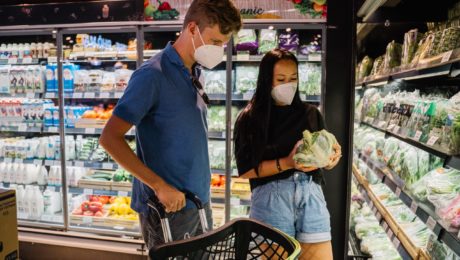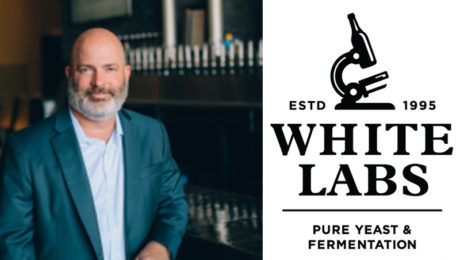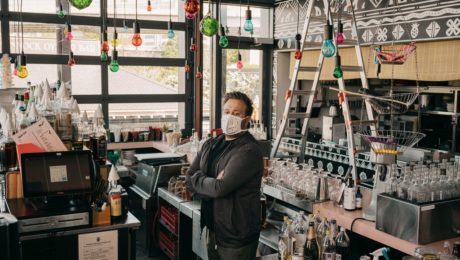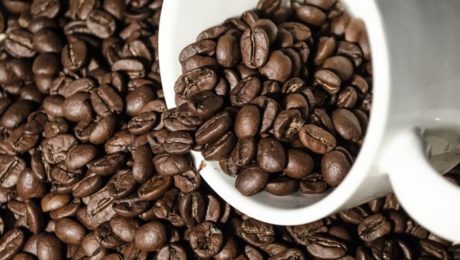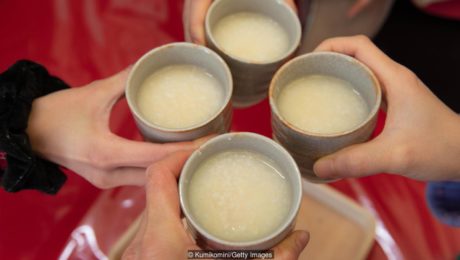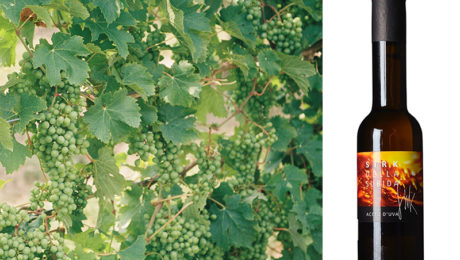Food and Beverage Laws Passed in 2020
Every year, the nation’s 50 state legislatures pass dozens of new laws that have an impact on fermenters. For example, some states amended alcohol laws to allow drink sampling for craft wineries, while others repealed outdated cottage food laws to help small producers operate and more loosened take-out restrictions to help small restaurants survive the pandemic.
Indicative of this year’s focus on the pandemic, laws were introduced but never debated as lawmakers focused on more pressing issues surrounding the coronavirus. The most common new laws passed in 2020 revolved around helping businesses survive — states called special sessions to aid restaurants, stop price gouging of high-demand products and provide emergency grants to small businesses.
Read on for key food, beverage and food service laws passed this year, most taking effect in 2021.
California
AB82 — Prohibits an establishment with an alcohol license from employing an alcohol server without a valid alcohol server certification.
AB3139 — Establishments with alcoholic beverages licenses who had premises destroyed by fire or “any act of God or other force beyond the control of the licensee” can still carry on business at a location within 1,000 feet of the destroyed premise for up to 180 days.
Delaware
HB 237 — Eliminates old requirements that movie theaters selling alcohol must have video cameras in each theater, and that an employee must pass through each theater during a movie showing.
HB275 — Permits beer gardens to allow leashed dogs on licensed outdoor patios.
HB349 — Permits any restaurant, brewpub, tavern or taproom with a valid on-premise license to sell alcoholic beverages for take-out or drive through food service, so long as the cost for the alcohol did not exceed 40% of the establishment’s total sales transactions.
Hawaii
SR84 — Creates a Restaurant Reopening Task Force to help restaurants in Hawaii safely reopen that were closed during the COVID-19 pandemic.
SR94 — Urges restaurants to adopt recommended best practices and safety guidelines developed by the United States Food and Drug Administration and National Restaurant Association in response to the COVID-19 pandemic.
Idaho
HB343 — Amends existing law to require licensing to store and handle wine as a wine warehouse.
HB575 — Allows sampling of alcohol products at liquor stores, which was formerly forbidden under law.
SB1223 — Eliminates obsolete restrictions on food products, to match federal standards. It repeals requiring extra labels on some imported food products, and repeals using enriched flour in bread baking.
Illinois
HB2682 — Amends Liquor Control Act of 1934. Allows a cocktail or mixed drink placed in a sealed container at the retail location to be sold for off-premises consumption if specified requirements are met. Prohibits third-party delivery services from delivering cocktails or mixed drinks.
HB4623 — Amends Food Handling Regulation Enforcement Act, regulating that public health departments provide a certificate for cottage food operations, which must be displayed at all events where the licensee’s food is being sold.
Iowa
HB2238 — Amends code regarding food stands operated by a minor. Bans a municipality from enforcing a license permit or fee for a minor under the age of 18 to sell or distribute food at a food stand.
Kentucky
HB420 — Implements Food Safety Modernization Act, authorizing a department representative to enter a covered farm or farm eligible for inspection.
SB99 — Amends alcohol laws for state’s distillers, brewers and small wineries. Eliminates the sunset on local precinct elections to grant distilleries, and allows distillers to sell other distiller’s products.
Louisiana
HR17 — Allows third-party delivery services to deliver alcohol.
HB136 — Makes adulterating a food product by intentional contamination a crime.
SB455 — Increases the size of containers of high-alcoholic beverages.
SB508 — Gives restaurants protection from lawsuits involving COVID-19. The public will be unable to sue restaurants for COVID-19-related deaths or injuries, as long as the restaurant complies with state, federal and local regulations about the virus.
Maine
LD1167 — Encourages state institutions to serve Maine food and Maine food products, increasing the visibility of the state’s local food producers.
LD1884 — Amends current laws regarding businesses that hold dual liquor licenses, which authorized retailers to sell wine for consumption both on- and off-premise. Retailers with the dual license can now sell with just one employee at least 21 years of age present, and adds that wine can be sold for take-out if food is part of the transaction.
Maryland
HB1017 — Allows cottage food businesses to put their phone number and business ID on their food label, rather than their address as currently required by the Maryland Department of Health.
SB118 — Expands definition of “alcohol production” and “agricultural alcohol production.” The new definitions aim to give Maryland farmers and producers the ability to sell beer, wine and spirits to increase agritourism.
Massachusetts
SB2812 — Expands alcohol take-out and delivery options during COVID-19 pandemic. Allows restaurants to sell mixed drinks in sealed containers alongside other take-out and delivery food orders.
Michigan
HB5343 — Revises regulations on brewpubs and microbreweries, increasing the quantity of beer a microbrewer is permitted to deliver to a retailer during a year from 1,000 barrels to 2,000 barrels.
HB5345 — Amends the Michigan Liquor Control Code to delete the Michigan Liquor Control Commission (MLCC) $6.30 tax levied on each barrel of beer manufactured and sold in Michigan.
HB5354 — Amends the Michigan Liquor Control Code to delete the requirement that a brewpub cannot sell beer in Michigan unless it provides for each brand or type of beer sold a label that truthfully describes the content of each container.
SB711 — Establishes new limited production brewer license for microbreweries at cost of $1,000 for license.
HB5356 — Amends the Michigan Liquor Control Code to ban the required $13.50 cent-per-liter tax on all wine containing 16% or less of alcohol by volume sold in Michigan.
Minnesota
HB5 — Authorizes emergency, small-business grants and loan funding for businesses affected by COVID-19.
HB4599 — Extends period of mediation for Minnesota farmers suffering economic difficulties to keep their farm.
Mississippi
HB326 — Amends outdated code to increase the maximum annual gross sales for a cottage food operation (from $20,000 to $35,000) before the producer would need to pay food establishment permit fees. Authorizes a cottage food operation to advertise products over the internet.
New Jersey
AB2371 — Requires large generators of food waste (like restaurants and supermarkets) to recycle food garbage rather than send it to incinerators or landfills.
AB3865 — Limits return of food from retail food stores during a public emergency.
SB864 — Prohibits sale of single-use plastic carryout bags, single-use paper carryout bags and polystyrene foam food service products, and limits single-use plastic straws.
SB1591 — Allows alcoholic beverages to be consumed from open containers in the Atlantic City Tourism District.
SB2437 — Limits service fees charged to restaurants by third-party food takeout and delivery applications during COVID-19 pandemic.
New Mexico
SB3 — Enacts the Small Business Recovery Act of 2020, which provides loans for small businesses suffering during the coronavirus pandemic.
New York
SB8225 — Authorizes issuing a retail license for on-premise consumption of food and beverage within 200 feet of a church, synagogue or other place of worship.
AB8956 — Allows a licensed brewery or farm brewery to provide no more than four beer samples not exceeding four fluid ounces each.
SB1472 — Requires hospitals to offer plant-based food options to patients upon request.
SB7013 — Authorizes the manufacture and sale of ice cream or other frozen desserts made with liquor.
North Carolina
SB290 — The Alcoholic Beverage Control Regulatory Reform Bills, it allows distilleries the same serving privileges as wineries and craft breweries and reduces regulation on out-of-state sales.
Ohio
HB160 — Aid for the restaurant industry to recover from COVID-19 pandemic, the bill doubles the maximum number of Designated Outdoor Refreshment Areas (DORAs) that can be created in a municipality or township. Also allows Ohio’s small wineries to sell prepackaged food without regulation from the Ohio Department of Agriculture, creates bottle limits for micro-distilleries and permits license holders to sell alcoholic ice cream.
South Carolina
HB4963 — Amends state alcohol code, allows licensed retailers to give wine samples in excess of 16% alcohol, cordials or distilled spirits, as long as they don’t exceed a total of three liters a year.
SB993 — Amends state alcohol code to allow a permitted winery to be eligible for a special permit to sell wine at off-premise events. Also increases the amount of beer a brewery can sell to an individual per day for off-premise consumption.
South Dakota
HB1073 — Authorize special event alcohol licenses for full-service restaurant licensees.
HB1081 — Allows colleges to teach brewing beer and wine classes on South Dakota campuses to students age 21 or older. Brewing must be held off campus as the education institution is not deemed a licensed manufacturer. Any distilled spirits, malt beverage, or wine produced under this section may only be consumed for classroom instruction or research and may not be donated or sold.
Tennessee
SB2423 — Allows alcohol sales at the Memphis Zoo.
SB1123 — Encourages farmers who produce raw milk to complete a safe milk-handling course.
Utah
HB134 — Legalizes the sale of raw butter and raw cream in Utah;
HB232 — An agri-tourism bill that allows farms and ranches to host events that include food that would not need to be prepared in a commercial kitchen. Farmers must apply for a food establishment permit to use their private home kitchen.
HB399 — Changes to the Alcohol Beverage Control Act, prohibits advertising that promotes the intoxicating effects of alcohol or emphasizes the high alcohol content of an alcoholic product.
HB5010 — The COVID-19 Cultural Assistance Grant Program, which appropriates $62 million for struggling arts, cultural and recreational organizations and businesses across the state.
HB6006 — In response to the coronavirus pandemic, the bill amends the Alcohol Beverage Control Act, delaying the expiration date of the retail licenses set to expire in 2020 for places selling alcohol. Also permits alcoholic beverage licensees at international airports to change locations if needed.
Vermont
SB351 — A coronavirus relief bill which authorizes $36 million for agriculture and forestry sectors.
Washington
HB2217 — An update to Cottage Food Law eliminates the requirement that a home address must be put on a food label.
HB2412 — Increases amount of additional retail licenses for a domestic brewery or microbrewery from two to four, and directs health department to adopt rules allowing brewery owners to allow dogs on brewery premise
SB5006 — Allows sale of wine by microbrewery license holders.
SB5323 — A bill eliminating single-use, plastic carry-out bags
SB5549 — Modernizing resident distillery marketing and sales restrictions. Allows distilleries to sell products off-premise, similar to breweries and wineries.
SB6091 — Continues work on the Washington Food Policy Forum, including support for small farms and increasing the availability of food grown in the state.
West Virginia
HB4388 — Removes outdated restrictions on alcohol advertising, limiting the Alcohol Beverage Control Commissioner’s authority to restrict advertising in certain advertising mediums, such as at sporting events and highway billboards.
HB4524 — Making the entire state “wet,” permitting the off-premises sale of alcoholic liquors in every county and municipality in the state.
HB4560 — Permits licensed wine specialty shops to sell wine with a gift basket by telephonic, electronic, mobile or web-based wine ordering. Establishes requirements for lawful delivery.
HB 4697 — Removes restriction that a mini-distillery use raw agricultural products originating on the same premises
HB4882 — Allows unlicensed wineries not currently licensed or located in West Virginia to provide limited sampling and temporary, limited sales for off-premise consumption at fairs, festivals and one-day nonprofit events “in hopes that such wineries would eventually obtain a permanent winery or farm winery license in West Virginia.”
Wisconsin
HB1038 — Bans customers from returning food items during a health pandemic or emergency, dissuading people from stocking up on too many supplies.
SB83 — Increases sales volume of alcohol by retail stores from four liters per transaction to any quantity.
SB170 — Allows minors to operate temporary food stands without a permit or license.
Wyoming
HB82 — Authorizes a microbrewery to operate at more than one location. The local licensing authority may require the payment of an additional permit fee not to exceed $100.00.
HB84 — Authorizes the sale of certain homemade food items that do not require time or temperature control. These include but are not limited to:
but is not limited to, jams, uncut fruits and vegetables, pickled vegetables, hard candies, fudge, nut mixes, granola, dry soup mixes excluding meat based soup mixes, coffee beans, popcorn and baked goods that do not include dairy or meat frosting or filling or other potentially hazardous frosting or filling;
“non-potentially hazardous” (no dairy, quiches, pizzas, frozen doughs, foods that require refrigeration and cooked meat, cooked vegetables and cooked beans). Allows someone other than the producer to sell the food, as long as food is not sold in a retail location or grocery store where similar food items are displayed or sold. Food must be labeled with “food was made in a home kitchen, is not regulated or inspected and may contain allergens.”
HB158 — Allows microbreweries to make malt beverages at multiple locations rather than one as deemed in current law.
Retail Sales Trends for Fermented Food and Beverage
Kimchi, fermented sauces and tempeh are driving growth in the fermented food and beverage category, a $9.2 billion industry that’s grown 4% in the last year.
“We’re excited about the growth potential for fermented food. While fermented food represents about 1.4% of the market today, there are segments that are tracking well above the growth of food and beverage [overall] that are poised for disruption in the future,” says Perteet Spencer, vice president of strategic solutions at SPINS. Spencer shared this information in a recent webinar hosted by The Fermentation Association. “There’s a ton of opportunity to scale and increase the footprint of these products.”
SPINS spent weeks working with TFA to define the fermentation industry’s sales, drilling into 10 fermented product categories and 57 product types. Wine, beer and cheese sales were excluded from the data — those categories are very large, and would obscure trends in smaller categories. (All three are also well-represented by other organizations.)
Pickles and fermented vegetables “is a space that’s seen [a] pretty explosive uptick in growth over the past year,” Spencer says. Every segment is growing — kimchi, sauerkraut, beets, carrots, green beans, sliced and speared pickles and all other vegetables — with pickles the largest, nearly 60% of the category.
The biggest growth, though, is coming from products other than pickled cucumbers. Kimchi is at the center of numerous consumer retail trends. Consumers are purchasing healthier food made with fewer ingredients, and they want food with international flavors. Kimchi makes up only 7% of the category, but sales are increasing at an explosive 90% growth rate.
More people are experimenting with fermenting while they’re at home during the coronavirus pandemic, but these kitchen DIYers do not appear to be detracting from sales.
“The more people make fermented foods, they appreciate what’s available in the store that maybe didn’t exist five or 10 years ago,” notes Alex Lewin, author and TFA advisory board member who moderated the webinar. “Anyone who has made kimchi knows it takes a lot, it makes a big mess, you get red pepper powder stuck under your fingernails and onion in your eyes. I can make kimchi (at home), and then once I’ve made kimchi, I’m like ‘Ok, maybe next time I’ll buy it.’”
Fermented sauces are also growing, up 24% in 2020. The largest segment in sauces is, of course, soy sauce, almost 85% of the category. But gochujang, less than 2% of the category, is increasing at over a 56% growth rate.
Versatility is helping sauces, pickles and fermented vegetables, Spencer says. Any food product with multiple uses is selling well. The condiments and sauces can be used as a topping on eggs, hamburgers or pizza, or mixed-in a salad, rice dish or soup.
Sake, plant-based meat alternatives and miso had combined annual growth of $75 million in 2020. Sake grew 16%, and both plant-based meat alternatives and miso each grew 26%.
Yogurt and kombucha still dominate the fermented food and beverage market. Yogurt is 81% of the market; if yogurt is removed, kombucha is 51% of the remainder.. Both have experienced slowdowns in sales from their peaks. Kombucha sales have slowed recently, as grab-n-go opportunities have shrunk during the pandemic.
Yogurt giant brands Chobani, Yoplait and Dannon still dominate the category, as do GT Kombucha, Health-Ade and Kevita reign for kombucha.
Spencer notes the 4% growth rate of fermented products overall would be higher without yogurt. It’s a large category that — despite an uptick in 2020 during the pandemic – has been fairly flat in recent years. Core (traditional) yogurt has been growing at a 1.6% rate; Greek yogurt, at about twice that pace. Those two segments account for roughly 80% of the category.
“This is an opportunity for disruption for emerging brands,” Spencer says. “We’re already seeing some of the legacy segments start to get disrupted by new innovation, so I’m excited to see the evolution of that innovation and where that goes and kind of what opportunities peek out of that.”
“Overall, we’re seeing historically small segments gaining traction in the marketplace,” Spencer adds. “The pandemic has brought a renewed consumer focus on the fermented space.”
Though fermented products have an added healthy benefit, customers are looking for delicious flavor first.
“In these fermented categories we covered today, taste first is always really important. I think people are going to these categories for different taste experiences,” Spencer says. “If you can level up with a functional benefit, that’s fantastic, but we have to balance the taste first. If it’s highly functional but doesn’t taste good, it just doesn’t have the same success.”
- Published in Business
Q&A with Chris White, White Labs
As a biochemistry grad student with a penchant for homebrewing, Chris White never thought his growing collection of yeast strains would amount to anything outside a hobby. But when White graduated with his PhD and was offered a lucrative job in the biotech field, one caveat kept him from accepting the offer — there were no side jobs allowed.
“I never had some big plan to start a company. But I liked all the fermentation stuff I was doing and didn’t want to let go of my yeasts,” says White, CEO and founder of White Labs. “I said no to the job, and from there White Labs kept going and going and getting bigger and bigger.”
Today, White Labs is a powerhouse in the fermentation industry. They provide professional breweries with liquid yeast, nutrient blends, educational classes, analytic testing and private consulting.
White Labs is celebrating a landmark 25th anniversary this year, despite a global pandemic that has shuttered breweries. They have released their own line of beer, created a new nutrient blend for hard seltzer brands, began a YouTube series and launched free how-to education classes for homebrewers. White Labs will host a year in review webcast on Dec. 9.
“We’ve had a lot of success and we’ve made a lot of mistakes, and we’ve tried to learn from those mistakes. But we’re a team. And we really got lucky that we hired people interested in fermentation that helped build this company,” White says. “Everyone really pulled together during COVID and did whatever was needed. It’s been a great experience because we had solutions and we had teamwork. And I think it’s taken 25 years to get to that team, that tribe.”
A yeast guru, White is a co-author of the book “Yeast: The Practical Guide to Beer Fermentation.” Below, check out our Q&A with White.
The Fermentation Association: You studied biochemistry at University of California, Davis, then got your PhD in biochemistry at University of California, San Diego. What made you decide to dive into yeasts?
CW: I was always interested in science since high school chemistry, and then in college was interested in how cells work, how DNA worked. It drove me to where I am today, really. Most people I went to school with at UC Davis, they were studying biochemistry to be a physician. But that’s not what I wanted to do, I was more interested in biotech and grad school.
Meanwhile, I was homebrewing. It was a great combination of things that happened. The science and homebrewing is what led me to put that together and make yeast for homebrewing, then yeast for craft brewing.
TFA: Is that what led you to start White Labs?
CW: It really was. I like beer. I was fascinated with how it could be made. It’s pretty simple to make beer — simple, but not easy. It’s difficult to make a great beer. But it’s fairly simple since it’s only four ingredients if you include the water. That’s what’s great about a lot of fermentation, the raw materials are all around you. They’re simple. Making it taste good is the hard part, that’s the art of it. I liked beer, I really got into homebrewing, then the people I was making homebrewed beer with started a store in San Diego, Home Brew Mart, in 1992. We became friends and that’s who I was homebrewing with every weekend. Then my friend from the store said “Hey, we need yeast,” and I started a little company on the side to make yeast. It wasn’t like I had some big plan to start a company, I thought I’d just make a little each week. And then other people asked and other people asked. By the time I got closer to finishing grade school, I just didn’t want to stop doing the yeast for brewing.
TFA: Now there are over 1,000 strains of yeast in the White Labs yeast bank. Tell me about it.
CW: We have a yeast bank that I spent a lot of time building in the beginning, more for my own brews, but obviously later on, it became more and more. The foundation of our company is our yeast strains and the way we store them. We’re collecting strains all the time. But what I did in the beginning was collect different strains from travel, from different yeast banks. We created our own private yeast bank at White Labs, but there are yeast banks around the world. Especially in Europe where brewing really began in an industrial way and where yeast was discovered and started to get collected. There’s a great yeast bank in Denmark, Germany, the UK. I spent a lot of time acquiring strains from those.
You get to know the yeast in a different way, the strains, what they do. Performance, conditions. But for beer especially, it’s really how they taste, which is so important. We only make those flavors through fermentation. We still continue to acquire strains. People send them to us, we bank private strains for companies, sometimes they buy them in a liquid form we make for them, sometimes we just store it for them. But usually, they’re banking it for us to make something with it.
TFA: Besides yeast, White Labs offer testing services as well.
CW: White Labs Analytical Lab is really separate in the fact that a lot of people that work in that lab don’t really have anything to do with the yeast. It’s just testing samples. They’re usually fermented beverages. Yes, there’s beer there, but that’s just a part of White Labs Analytical Lab. There’s the spirits that come for testing, kombucha, cider, mead, any kind of commercial business making a fermented beverage that needs some kind of testing. Sometimes it’s regulatory for export. Sometimes it’s just for their own data, like actual alcohol by volume instead of calculated, sometimes it’s microbiology or tracking down a problem or contamination. It’s all confidential, like everything at White Labs. But we get to work with a lot of cool companies, a lot of them may not get yeast from us, that’s really not a requirement. The yeast and testing run separate.
TFA: Have you seen kombucha brewing grow?
CW: Oh yeah. Originally, that’s how we got into analytical testing because people were asking for alcohol lab evaluations, which is so important in kombucha. We all know what happened there (Whole Foods pulled all kombucha bottles off shelves in 2010 after several brands tested at higher alcohol beverage levels then what was printed on the bottles). And it happened because it’s a biological process. You put that thing in a bottle and it’s going to keep fermenting. People had to really try to figure out what to do with that. So a lot of alcohol testing, and a lot of that is regulatory in kombucha.
But then we started making SCOBYs because a couple of our staff got really into it. Just like I started making yeast in my own home brewing, they started making SCOBY in White Labs for their own kombucha making. So we said “Let’s sell it.” And now we make a bunch of it.
TFA: That’s forward-thinking, expanding your offerings to all fermented drink products.
CW: Yeah and the different facilities allow us to do different things. We grow all the SCOBYs in North Carolina because it was a new facility at the time and had the space, San Diego is full.
TFA: White Labs released their own canned beer in July. Tell me about it.
CW: A lot of the things that came out of this year really were not new ideas, like canning. Someone gave a presentation at White Labs during one of our internal innovation summits that’s open to anyone in the staff about canning beer. But during this time of COVID, when we’re not focusing on growth, we were able to work on a lot of those projects and really build a better company. Once we gave up the idea that revenue is not going to go up right now, we worked on other things. And it’s been great. A lot of cool things have been coming out of our teamwork this year, and one of those was canning.
So we said let’s do that because we’re not selling beer in our tap room — we’ve got a tap room in San Diego for White Labs Brewing Company and a kitchen and tap in Asheville, it’s more of a full restaurant. We weren’t selling a lot of beer and we have a lot of beer, so why not can it? We have done three different beers now in cans. The IPA, a hazy IPA and the pilsner. And we’re going to do another lager and IPA next month. It’s been fun for the brewers to be able to brew it. I think it’s been a nice boost for everyone in the company, not even money wise, just to have another milestone: we put our beers in cans. It’s a nice billboard for the brewery. And they get to have fun with graphics, and how to tell our story, and really share what we’re doing in the tap rooms.
People are amazed that it’s the same beer, same exact batch but put into smaller fermenters and pitched with two different yeast strains. They say “Wow, you created different flavor beers? They taste different?” Yeah, because that’s fermentation. Fermentation makes these flavors and when people taste that it’s the same exact beer made with two different yeast strains, they get it in 30 seconds. “Oh that’s what a yeast does?” But you have to come to our tap room to experience that. And obviously during these times, you can’t come to the tap room. But canning is a way to share that with people outside the tap rooms.
TFA: Who buys more yeast from White Labs — commercial producers or homebrewers?
CW: Commercial because of volume. But we’re available for everything in homebrew. We try to mirror every test, every yeast strain, and make those available for home brewing because that’s our roots and I think it’s important. There’s been growth in home brewing during COVID. People at home with a hobby are buying yeast. That’s kind of nice, I like to see that.
TFA: Craft brewing has been hit so hard by pandemic. What have you seen your clients doing to survive?
CW: They’re getting creative. People had to figure out the to-go thing, first of all. That maybe involved buying software or creating a new website. Each company I talk to, regardless of what industry, they had to do something technology wise. Very few could close the bar door and were all set up to sell everything through the warehouse.
I think customers were also really good about supporting local businesses, wanting to help them. There’s been a lot of to-go. But it still doesn’t compare to all the beer they could sell, all the stuff that gets sold through bars. Even if one little meadery sells more to go, it doesn’t replicate all the tap room business that just disappears.
TFA: What do you think is the future of the fermented drink industry?
CW: It’s up to them. We pay attention so we can be there to help. But really these things come from creative people. New things have to come out. That keeps the industry growing. And I don’t know what those new things are, but we try and pay attention.
I think transparency and honesty is a hallmark of fermentation industries — whether craft breweries or wineries — and I hope that stays. That’s been a big part of the trust with consumers, and the fact that you can do these things at home too, so you know how it’s done. And with new techniques or things that get introduced, I think the industry needs to keep the transparency part of the business. Because fermentation being such an old, old method — a lot of people would like to replace fermentation with something else. They say “Let’s just mix these things together rather than do that weird fermentation.” But weird fermentation is what makes it so special.
- Published in Business, Food & Flavor
Cider 2020: The State of the Art of Cidermaking
When Kirsten and Christopher Shockey moved onto their southern Oregon farmland 22 years ago, they envisioned starting a cidery. The century-old apple trees on the property produced perfect cider apples with an optimal mix of tannins and sugar. Cider ignited their love of fermentation.
“Really our fermentation journey started here on this place,” says Kirsten, author and fermentation educator (as well as a TFA Advisory Board member). She and her husband spoke at a recent TFA webinar Cider 2020: The State of the Art of Cidermaking, and talked about the state of the industry today.
This year has been full of surprises for cider producers. Sales had begun to flatten in 2019, as drinks like hard seltzer pulled from their market share. But, as the COVID-19 pandemic took root this spring, consumers started buying large amounts of cider, hoarding it along with toilet paper and hand sanitizer. Regional brands in particular have netted strong growth, some seeing gains of up to 30%. But this short-term growth spurt has created an odd, contradictory situation in the industry.
“We’ve got this real interesting dichotomy,” Christopher says. “Cider sales are up over 12%, but when you talk to orchards, farmers, cideries, especially small ones, you get a different picture. A lot of our friends in the cideries are cutting back their production, they’re not buying as many apples. Cideries are cutting back their apple orders.” The Shockeys theorize that these recent sales have been filled from existing inventories, while producers remain cautious about sales projections for 2021 and beyond.
What does this all mean for you as a cider producer, as well as for the future of the industry? The Shockeys shared their recommendations, observations and predictions.
- Pick a niche. What is your cider brand’s defining characteristic? Is it your background story? Where do you source your apples? Differentiate, Christopher advises.
- Focus on target demographic. Different age groups purchase alcohol differently. Millenials and Gen Z, for example, avoid wine. How can your cider cater to your target age group?
- Respond to consumer movement. People are leaving the city for the country, as more and more work remotely and are no longer tethered to an urban office location. This migration will affect distribution and sales patterns as consumers relocate around the country.
- Find unique marketing opportunities. Though many tap rooms are currently closed, cider clubs are finding success providing the latest flavors to customers 4-6 times a year. These are guaranteed sales, and help cideries sell out of kegs rather than bottles.
- Embrace unusual flavors. The Shockeys detailed the differences between traditional cider (apples only) and modern cider (using other fruits and botanicals). Christopher’s favorite is a persimmon cider, while Kirsten loves one made with manzanita yeast that produces a Christmas spice flavor. In 2020, pineapple-flavored ciders have sold particularly well.
- Understand there will be less business spending. Restaurants, hotels and conferences will not be reliable sources of income for cider makers until the coronavirus pandemic is over. Even then, it may take a while for these outlets to recover.
- Explore home delivery. Regional brands implementing home delivery are seeing big sales.
- Fight for fridge space. People are not getting bigger refrigerators and they’re not drinking on-premise during the pandemic, so cider makers must figure out how to compete for their share of consumer purchases.
Attending Cider 2020 was a range of individuals, from master cidermarkers to DIY home brewers. The Shockeys shared tips for hobbyists as well as professionals. They also offered further advice through a chapter that didn’t make it into their recently-published The Big Book of Cidermaking but is available here: www.storey.com/cider-business.
For anyone interested in purchasing The Big Book of Cidermaking, or in any of the Shockeys’ four titles on fermentation – a fifth, on vinegar, will be released next year – please visit the Shockey’s Amazon store.
- Published in Food & Flavor
6 Trends for Non-Alcoholic Fermented Drinks
When consumers buy beverages today, they want drinks that go beyond simply quenching thirst. Drinks today need to meet consumer’s health needs, too — improving sleep habits, aiding gut health, lowering stress levels and boosting energy.
“There’s this real explosion of outcome-based beverages in the industry at the moment,” says Howard Telford, head of soft drinks for Euromonitor International. “Ten years ago, it was easy to identify what was an energy drink. That’s no longer the case, clearly. Because every category now has some form of products on the shelf with a functional proposition. These ingredients-based category lines are blurring. Consumers are rethinking what’s our morning option, what’s our late afternoon option, what’s our evening beverage.”
Clean ingredient lists with functional appeal will differentiate brands. In a beverage trends webinar hosted by FoodNavigator, brand leaders in the beverage industry shared their insight. Here are six beverage trends for 2020:
1. More Consumer Need States for Different Ingredients
Modern beverages straddle between food and dietary supplements.
“Every time (consumers) spend a dollar on a drink or a food item, they want that food or drink item to do more for them,” says Chris Fanucchi, co-founder of drink brands Limitless and Koia. “Brands are starting to put more marketing on the front of their labels, that say ‘Hey, we help you with calming you or with inflammation or with pain or anxiety.’ As consumers start to see that more and more, they’re going to start to expect that. And the second they start to expect that is when the consumers are going to be demanding that their beverages have more and more function to them. So a functional beverage right now I think is definitely about identifying those need states that are more relevant to consumers today.”
2. Mindfully Purchasing Natural Health Products
Consumers are looking for ingredient lists without artificial ingredients (33%) and with limited or no sugar (35%), according to research by Euromonitor International. Sixty percent are following diets – lowering carbs and saturated fat, monitoring weight and tracking calories.
Holly McHugh, marketing associate with Imbide, thinks consumers will seek out healthier products at the end of the coronavirus pandemic. “Like a detox that you see in January because people have overindulgences over the holidays…I do think there will be a bump when people go back to their normal lives.”
“There’s absolutely a stigma against sugary products for your overall health. And people are really concerned about their health right now,” McHugh says.
However, McHugh doesn’t think brands will completely abandon sugar. Instead she hypothesizes brands will provide more options. Like a full-sugar, low-sugar and no-sugar drink, then drinks with alternative sweetener like stevia and natural sweetener like honey.
3. Rise of Cannabis/Hemp in Beverages
Consumers are experiencing mounting stress due to the pandemic and are seeking drinks with stress-reducing ingredients.
Estimates show legal cannabis sales will rise to $150-170 billion by 2023 according to Euromonitor International, mostly from North America. Huge innovations in CBD industry as proving hemp-derived drinks is a growing market. CBD-infused beverages grew by 500% last year.
“I think CBD is going to be a very big category,” adds Thomas Hicks, chief growth officer for Ojai Energetics, which produces various CBD products, including a CBD drink. “The consumer demand is phenomenal and you can see that online. About 90% of our business is direct to consumers.”
Ojai Energetics has seen sales increase 20% during the pandemic.
CBD is poised to become as big of a category as energy drinks. However, more clarity around CBD needs to be provided by the Food & Drug Administration. Thomas notes the FDA has not yet defined the different elements of CBD.
“It’s a race to the bottom if you don’t have really good branding and, quite honestly, a patented process,” says Hicks, who has formerly worked with big drink giants like Hansens and Coca-Cola.
4. Cost Major Factor During Health, Economic Crisis
Brands looking to add more premium ingredients to their drinks need to note consumer’s pocketbooks. Howard Telford, head of soft drinks for Euromonitor International, said he predicts certain drink categories will decline because of cost in a COVID-19 era.
“This event (coronavirus pandemic) is translating to an economic crisis more than a public health crisis, I think we have to be very cognizant of price,” he says.
Comparing sales during the 2008 Great Recession, Telford says consumers will trade down premium products. “Affordable luxury” needs to be the focus of new drink launches, adds McHugh.
“I think cost will be a really important consideration given the uncertainty of the economy right now,” McHugh says. “Brands will need to introduce products that are affordable and meet those clean, quality, functional qualities during this time.”
5. Brands Need to Better Educate Consumers
As more consumers routines are impacting during the outbreak and they turn to healthy eating during, will they turn to kombucha over Coke? Telford believes so. Long-term, consumer’s beverage choices will change because of COVID-19. They’re reducing sugar, trusting health ingredients.
“When we decide to indulge, we’re conscious of the ingredients in those products,” he adds.
Especially CBD.
“There’s still so much education around CBD with the general public,” Hicks adds.
Research provides CBD helps regulate the immune system, and consumers are becoming savvier and seeking out that research, Thomas says. Key, he adds, is researching the specifics behind CBD brands. Brands should publish their lot number certification online. Consumers should easily be able to research CBD batches should go through two different labels to make sure they are acceptable and organic, he advises.
6. Shelf Brand Launch Until Post Pandemic
Faccuchi, who sold Limitless to Pepsi/Keurig last year, said smaller companies are struggling securing capital to launch. An entrepreneur, Faccuchi invests in beverage companies.
“Lots of clients, especially in the energy category, are having zero luck with retail meetings, confirmation of placement on shelves,” Faccuchi says. “They’re seeing around waiting for those opportunities. It makes it all the more difficult when there’s really no light at the end of the tunnel. These brands could lose a lot of cash over the next several months, they could go belly up.”
His advice to people wanting to launch a new beverage company: “Make sure the category you’re jumping into actually has a need. I run into a lot of entrepreneurs who build this awesome product out of different ingredients that you’d never hear of, and the unfortunate truth is some of those ingredients are just not supply chain ready. So you can’t get the price point necessary for consumer to actually try the brand, which is the No. 1 thing when you’re launching a new company. So make sure you’re identifying a need space that people actually have. Your best way to test that is online marketing.”
Find people in food and beverage industry that are looking to champion brands, he advices. “Those people do exist.”
Craft Breweries Once Surging, Now Shuttering
Craft breweries, which were heading into their second decade of a major boom, are now shuttering during the coronavirus pandemic. “There’s going to be a lot of dead distilleries coming out of this,” said Paul Hletko, the founder and distiller of FEW Spirits, in Evanston, Ill. “Even if you survive, the new normal is going to be punishing for small brands.” Craft distilling relies on bars, tasting rooms, face-to-face sales and customers willing to pay a higher price for a premium product — all factors dramatically changing with social distancing and a global recession.
Read more (The New York Times)
- Published in Business
Functional Foods Grew 5.3% in 2019
Sales of functional foods and beverages — products that provide additional nutrients — grew 5.3% to $71.4 billion in sales in 2019, at a growth rate two times faster than conventional products. Sales of function foods and beverages were $68 billion in 2018. (New Hope Network)
- Published in Business
Coffee Prices Surge During Pandemic
The coronavirus outbreak forced coffee prices to spike in April, with coffee futures estimated to rise 15% in May. Though prices are high, coffee farmers internationally are suffering. The COVID-19 lockdown in Colombia is disrupting coffee exports, the lockdown in Brazil is causing container shortages and a locust invasion in East Africa is hurting harvests. Despite rising prices, consumers are still purchasing coffee. CNBC analysts suggest the price increase could be short lived, as coffee shops reopen again and the public begins consuming stockpiled coffee supplies.
Read more (Food Dive)
- Published in Business
Amazake Garners Popularity as Health Drink in Japan
Amazake — an ancient, fermented superdrink from Japan — is jumping in sales in Japan. Boyband Kanjani Eight was even hired as spokespeople for Hiyashi Amazake, a popular Japanese brand. Amazake was developed around 250 to 538 AD. It’s made by boiling rice, water and koji for 8-10 hours. It’s a sweet drink with a lumpy texture, and its name translates to “sweet sake” (thought it only has trace amounts of alcohol thanks to the fermentation process.) Amazake has earned the nickname “drinkable IV” because it’s packed with nutrients and gut-friendly bacteria. In Japan it’s considered a drink and a health product.
Read more (BBC)
Fermented Grapes Make “Orange Wine” of Vinegars
The new innovation in vinegars is grape vinegars. Grape vinegar is made from grapes macerated and slowly allowed to ferment with their skins for a year. “The fermented juice then spends several years in small oak barrels to evolve into the delicately fruity pinkish vinegar,” according to the New York Times. The white grapes and skin contact is why the grape vinegar makers call it to the “orange wine” of vinegars. The latest grape vinegar collection comes from Sirk in Friuli, a region in northeast Italy. The grapes grown there, Ribolla Gialla white grapes, are prized for wine making.
Read more (New York Times)
- Published in Food & Flavor

